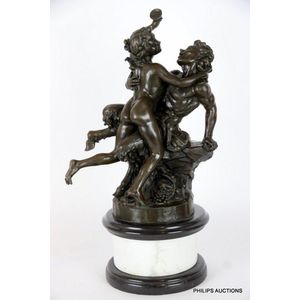Nymph and Satyr: The Intoxication of Wine
You must be a subscriber, and be logged in to view price and dealer details.
Subscribe Now to view actual auction price for this item
When you subscribe, you have the option of setting the currency in which to display prices to $Au, $US, $NZ or Stg.
- Terracotta - Terracotta is lightly fired earthenware, red or reddish-brown in colour, used in ancient times. Fired at higher temperatures terracotta was used in the nineteenth century for decorative vases and similar objects, but rarely for utilitarian goods. Other uses for terracotta include roofing tiles, garden pots and ornaments. Glazed terracotta is known as faience.
- Bronze - An alloy of copper and tin, traditionally in the proportions of about 9 parts of copper to 1 part of tin.
The discovery of bronze in Western Asia in the 4th century enabled people to create metal objects which were superior to those previoulsy possible because of its strength and hardness, and it has been used throughout the world for weapons, coins, tools, statuary and other decorative items.
It is very fluid in a molten state, and its hardness, strength when set, and non-corrosive properties makes it most suitable for casting sculpture. - Carrara Marble - Carrara marble is a type of white or blue-grey marble quarried in the Carrara region of Tuscany, Italy. It is prized for its beauty, durability and the ease with which it can be worked. The marble has been used for thousands of years for sculptures and architectural details, and was particularly popular during the Renaissance period. Some of the most famous sculptures in the world, such as Michelangelo's David, were carved from Carrara marble. It is also widely used in the construction of buildings, floors, and countertops, both indoors and outdoors. This marble is known for its unique veining which gives it a distinctive look, and it's a popular choice for interior design, especially bathrooms and kitchens.
- Satyr - A creature from Greek mythology with goat-like features, including a bearded face and horns, a man's torso, hairy legs and cloven hooves and a tail. As attendants of Bacchus, satyrs sometimes carry grapes or pitchers of wine. As spitis of fertility they may carry a cornucopia or basket of fruit.
They are also used to portray lust, and are often depicted with a leering expression. As well as being depicted singly or in a group in sculpture and candelabra, they also appear as motifs on ceramics, glass, silver and gold objects.
This item has been included into following indexes:
Visually similar items

Aldo Vitaleh (20th C) Bronze figure, Standing Woman figure, signed to base. On marble base. Height 29 cm (total)

A 19th century bronze mercury figure, after Giovanni da Bologna. Height 82.5 cm

Tibetan bronze of green Tara, 19th century, the female bodhisattva of enlightened activity, seated on a lotus throne in the posture of royal ease with right leg extended. Her left hand holding the stem of a upala flower which blossoms with a varja at her s

A rare Himalayan bronze six-armed Bodhisattva, Circa 16th century. Very finely cast seated on a double-lotus throne, wearing a five-point crown and holding two discs aloft, the face serene and eyes downcast, possible from the bon religion. 24.5 cm high. Pr
